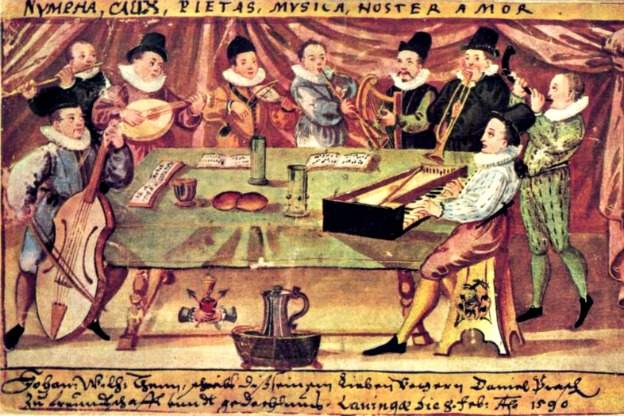
Dubbed the “Father of Musick” by the King of England, William Lawes stands as one of the most inventive English composers of the 17th century. Two recordings highlight three aspects of Lawes’ output: a 2013 release from the Flora label presents several harp consorts on a disc titled, The Passion of Musicke, and the ensemble Phantasm presents Lawes’ Consorts to the Organ in 5 and 6 parts on a 2012 Linn Records release.
The Passion of Musicke
If you’ve heard any of our Harmonia radio broadcasts lately, you’ll probably be familiar with our ongoing series A Listener’s Guide to the Renaissance Consort. In the past, we’ve explored the viol, shawm, sackbut and vihuela, and next month, we’ll be featuring the harp as an instrument of the Renaissance consort. A consort combines different sized instruments of the same family or mixes instruments from different families. Lawes’ harp consorts are of this second type, a mixed (or sometimes called broken) consort of harp, bass viol, violin and theorbo.
Lawes’ 30 or so compositions for this mixture creates wonderful musical interplay between instruments. Listen to some of this Pavan from the g minor suite that also incorporates divisions or ornamented variations passed back and forth between the violin and viol.
The two plucked instruments and two bowed instruments together create a really special soundscape, especially when Lawes gives each its instrument its own independent part. In this fantasy from the d minor consort suite, no two parts double—not even the bass line—in fact, Lawes takes advantage of the harpist's ability to use both hands to play multiple lines, creating at times even a 5 or 6 part texture.
Phantasm
Lawes’ Consorts to the Organ are also in 5 and 6 parts, but in contrast to the harp consort we just heard, the organ mostly doubles and blends into the sonority of a whole consort of viols. From this homogenous instrumental texture, the organ emerges only every now and then as an independent voice. This track from Phantasm’s latest recording especially holds my interest. I can’t wait to hear what will come next, and with Lawes there are always some unexpected twists and turns.
Lawes’ part writing, mannerisms, and a compositional style that breaks every rule in the book, is immediately noticeable in these pieces; that is to say, his music is in the very least distinctive. If you happen to go out and pick up this Phantasm recording, enjoy the CD booklet notes by Laurence Dreyfus, which he titles “A Guide to the Perplexed.” If there is one point Dreyfus clearly makes it’s that in the whole of music history Lawes’ music represents an apex of the strange and wonderful.
Something that’s particularly special about this Phantasm CD is that it includes some never before recorded alternate versions of the Lawes organ consorts. There are also well-loved favorites, like the fantasy from the set in F, a piece that has been nicknamed the “Sunrise” for its series of rising triads.









